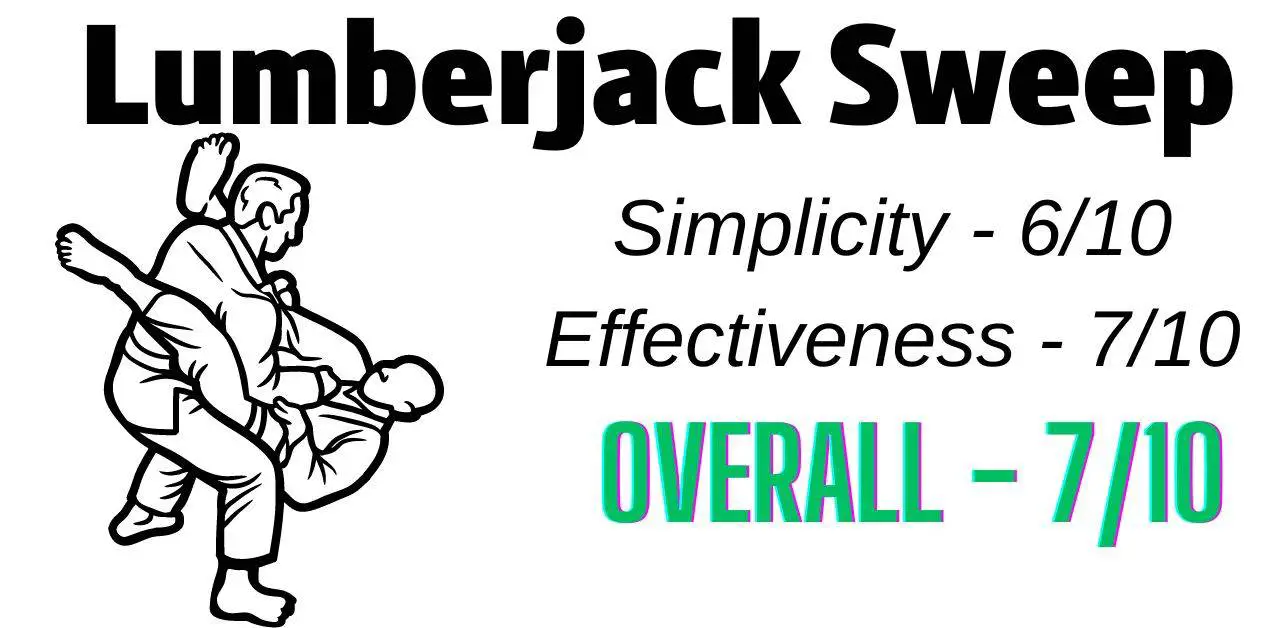So you want to learn the Lumberjack Sweep and do it fast. You came to the right place. This article is designed to teach you the fundamentals quickly while optimizing your use of this sweep.
This article is built in a special order I use to teach BJJ techniques efficiently. That’s why I encourage you to read the article in order and not skip any section.
I also recommend you bookmark this post, so you can return to it and learn the variations of this sweep one by one and not simultaneously. This will shorten the time it takes to perform and master each variant.
The Lumberjack Sweep is one of BJJ’s most practical and influential sweeps. You can learn this sweep whether you’re a white, blue, or purple belt. It doesn’t matter, as it’s a straightforward, easy-to-learn sweep.

So without further ado, let’s dive into the first part of this article: Lumberjack Sweep Variations.
Lumberjack Sweep Variations (BJJ)
This first part of the article will review the different variations of the Lumberjack Sweep. After that, you want to start learning them individually to ensure you familiarize yourself with the different variations.
In BJJ, the more you know, the more capability you’ll have to adapt in real fights. BJJ is like chess; you want to learn many techniques, entries, guard passes, and finishing blows—since that will be your advantage.
Not many grapplers will invest the effort and time into learning techniques they won’t use. But you’re not everyone—and you’re currently reading this article.
I know you’ll be a more competent grappler after reading this post. But again, practice and experience are above all. Thus, be sure to practice at least one of the variations I’ll review in this article; if you don’t know which, stick with the first.
Let’s dive into the first one!
#1 – Lumberjack Sweep From Closed Guard
This variation is perhaps the most common one you’ll encounter. That’s why I listed it first, and I encourage you also to learn it as your first variation.
Although the order doesn’t matter as much, you’ll likely find this one the most suitable to your current grappling style.
Here’s how you perform the Lumberjack Sweep from the Closed Guard position:
- Start in Closed Guard
- Cross-grip the opponent’s wrist
- Wait for the opponent to stand up
- Place your hand between his legs
- Pull his ankle to your head
- Lean to the side
- Fall with the opponent
- Attain Full Mount
This is the most common way I see grapplers perform the Lumberjack Sweep. So I encourage you to keep reading through and start practicing this variant.
You could start sweeping your opponent not long after you learn this move. So don’t hesitate to begin—and let’s move on to the 2nd variant.
#2 – Lumberjack Sweep to Armbar
This variation starts the same as the previous one—but ends differently. You want to know at least that this variation is possible. Pulling it off isn’t that difficult, as all you need is a basic understanding of the Armbar.
I have a separate article on the Armbar explaining everything you need to know about it, so follow the link to read more about it!
Here’s how to perform the Lumberjack Sweep to the Armbar submission:
- Start in Closed Guard
- Cross-grip the opponent’s wrist
- Wait for him to stand up
- Insert your hand between his legs
- Pull his ankle toward your head
- Lean to the side
- Fall with the opponent
- Isolate his hand
- Roll to the side
- Finish the Armbar
This is also a reasonably simple move. You can combine this with the first one to learn two variations simultaneously. Learning the Armbar and Straight Arm Lock basics won’t take as long as you should already know.
The primary mistake grapplers will make here is the setup itself. They won’t set up this submission properly and will allow their opponents to react. For instance, they will not have a tight cross grip, disabling them of many options for advancing in the submission.
They might also not lean to the side, on their hips, when they go for the sweep. As a result, their opponents will be able to counter, such as by going for the Full Mount.
#3 – Standing Lumberjack Sweep
So this will be the last variation we’ll review. I typically present 4 different ones, but the Lumberjack Sweep is reasonably hard to play with.
The only difference for this one is the starting position. And still, I believe you want to know at least it exists, as it will be difficult to counter if you fall victim to it.
The primary difference here is the starting position. You’ll start with you and the opponent standing and get into the Jumping Guard, an effective way of getting closed guard while standing.
Here’s how this variation looks:
- Start standing
- Use the Jumping Guard to get into closed guard
- Insert your hand between the opponent’s legs
- Pull his ankle toward you
- Lean to the side
- Roll
- Attain Full Mount
Although it might look exciting and relatively extroverted, it’s simple to learn and use. By now, you know how to perform the Lumberjack Sweep properly. So we have now to use tweaks to play around with the variations.
We did that by changing the starting position and making ourselves more unexpected, a critical component of your grappling game.
Alright, fellas, this is it for the variations. Now let’s break down the first variation by seeing the exact step-by-step system to perform it properly. After that, we’ll break down each step to ensure you know how to perform each one flawlessly.
So here it goes!
How to Lumberjack Sweep
So yea, this part will break down the first variation we discussed. Then, this part will help you optimize the steps on your way to performing the Lumberjack Sweep.
While knowing all 3 variations is beneficial, focusing on one and mastering it will skyrocket your grappling game. That’s why I’ve decided to list this part as the second one, as it’s more important to learn the variations when you’re just starting.
Buckle up. We’re up for a bumpy ride!
Step #1 – Start in Closed Guard
The first step is the most obvious one: you want to start in the Closed Guard position. This position gives you many options, such as sweeping the fight, going for a submission, or attaining a far better position, such as Side Control or Back Mount.
It’s not as complicated to hold this position, as your sole purpose is to leave your legs wrapped. Now if the opponent tries to pass your guard by breaking your closed guard, well, great—that’s what you want to perform the Lumberjack Sweep.
While the Closed Guard position is basic, it’s not simple. You can optimize your Closed Guard game for years and still lose to someone who has trained to pass such a position for the same period.
Anyways, once you’re in Closed Guard, you can move into step #2.
Step #2 – Cross-grip the opponent’s wrist
The 2nd step is to grab the opponent’s wrist using a cross-grip. That is a cornerstone step of this sweep, so you don’t want to avoid it.
The cross-grip here is fundamental to ensure you get the Lumberjack Sweep correctly. Thus, it’ll be worth it not to skip this step, as you won’t be able to attain Full Mount without it.
Step #3 – Wait for the opponent to stand up
The next step is to wait for the opponent to stand up. While I’m not a fan of relying on the opponent, he’ll likely stand up in this position.
Your opponent wants to pass your guard; we understand that already. So he’ll also want to break your guard, which will be difficult. But the best way to do it is by standing up and applying pressure on your feet.
Now that this condition has been met, you can move on.
Step #4 – Place your hand between his legs
Once the opponent stands up, you must place your hand between his leg. As you can imagine, it’ll be the hand that doesn’t cross-grips his wrist.
The next step will be to pull his ankle toward your head. This is where you want to place your hand: in a position suitable for doing that, preferably a bit above his ankle.
Step #5 – Pull his ankle to your head
I already had revealed this step; anyways, you now want to pull his ankle to your head. This step is the first offensive move, as you’ll now start sweeping the opponent.
By now, the opponent knows what you’re going for. So you want to act quickly—to ensure you’ll eventually get this sweep successful.
But remember, slow is smooth, and smooth is fast. While you want to act quickly, panicking is the last thing you want to happen. So ensure to keep calm and work fast and smoothly.
Step #6 – Lean to the side
The next step is to lean to the side. This is the 2nd offensive move and cornerstone in the Lumberjack Sweep.
The opponent will not fall if you don’t lean to the side, so make sure you do that!
That’s the primary mistake novice grapplers make: they pull the ankle in without leaning to the side. You must pop your hip sideways to force the opponent to fall so that you can finish the move.
Step #7 – Fall with the opponent
You now want to fall with the opponent. This is pretty obvious but still worth mentioning. Expect the opponent to fall here and follow him.
It’ll be best not to force the opponent to fall and not follow him to attain Full Mount and finish the fight.
Step #8 – Attain Full Mount
Alright! The last step is to attain the Full Mount position. Congratulations, you’ve successfully performed the Lumberjack Sweep. Hopefully, reading about it was enjoyable, and you understood everything.
At the end of the day, it’s a relatively simple technique. However, it won’t be long before you make it a part of your muscle memory and become a capable user of this beautiful sweep.
The last step is attaining Full Mount, a superior position. From it, you can finish the fight by going for a submission, such as the Americana, Triangle Choke, and Guillotine Choke. Follow each link to read more about each submission.
Final Words
Learning the Lumberjack Sweep is relatively simple. You’ll be able to master it in no time, considering the fact that you should already have a solid BJJ foundation, such as knowing to use the Closed Guard position.
Sweeping the opponent will grant you the advantage quickly in the fight. It’ll allow you to attain a far more superior position and finish the fight.
That’s why I’m a big fan of sweeps; they allow you to get the advantage quickly.
My aim with this article was to present you with the information you’ll need to learn the Lumberjack Sweep quickly and extensively. As a result, I’ve decided to review its variations first and the breakdown second. Hopefully, you found it helpful and suitable.
But the Lumberjack Sweep isn’t the most effective one; here are BJJ’s most effective sweeps you want to learn to skyrocket your win-loss ratio.
And here are other articles you’d enjoy reading:
Flower Sweep (Pendulum): Complete BJJ Breakdown
Mastering the Elevator Sweep in BJJ – Guide
Scissor Sweep 101 – BJJ Technique Breakdown
Butterfly Sweep 101: BJJ Complete Breakdown
You can also sign to our Email Newsletter to keep up with our blog posts and get exclusive information and free products when we release them.

